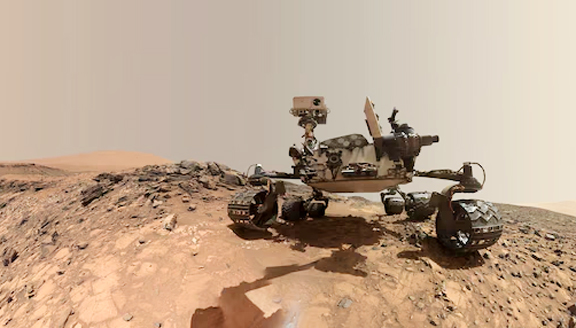DE Online Desk :
A groundbreaking discovery by NASA’s Curiosity rover has revealed new mineral evidence suggesting that ancient Mars once had a warm, wet climate—conditions that may have supported life.
NASA scientists announced that Curiosity, which has been exploring the Martian surface since 2012, uncovered high concentrations of siderite—an iron carbonate mineral—in rock samples drilled in 2022 and 2023 within Gale Crater.
The findings offer compelling support for the theory that Mars once possessed a thick carbon dioxide-rich atmosphere capable of sustaining stable bodies of liquid water.
The discovery is detailed in a new study published in the journal Science and provides a significant breakthrough in understanding the planet’s climatic and atmospheric evolution.
“This is among the most convincing pieces of evidence we’ve found that Mars once had the greenhouse conditions necessary for liquid water,” said Dr. Benjamin Tutolo, geochemist at the University of Calgary and lead author of the study.
The mineral siderite typically forms in watery environments under carbon dioxide-rich conditions.
Its presence in sedimentary rocks estimated to be 3.5 billion years old suggests that ancient Mars had a dynamic carbon cycle and potentially habitable conditions.
Until now, carbonate minerals like siderite had been detected only sparingly, leaving a key gap in the evidence for Mars’ warm and wet past.
Curiosity’s samples—collected from three distinct sites inside Gale Crater—contained up to 10.5% siderite by weight.
These results reinforce models suggesting that carbon dioxide, the same greenhouse gas that regulates climate on Earth, once played a central role in Mars’ atmospheric warming.
“This mineral discovery helps solve a long-standing mystery: if ancient Mars had the greenhouse effect needed for liquid water, where did all the carbon go?” added Dr. Edwin Kite, planetary scientist and study co-author.
“Finding carbon locked in these rocks provides a strong clue.”
Researchers believe that similar rocks found across Mars may also be rich in carbon-bearing minerals, potentially accounting for much of the planet’s missing atmospheric carbon dioxide.
The study also sheds light on the Martian carbon cycle, which appears to have become imbalanced over time.
Unlike Earth, which recycles carbon through plate tectonics and volcanic activity, Mars lacks these mechanisms.
As a result, more carbon may have been sequestered into rock than was ever released back into the atmosphere—possibly leading to the dramatic cooling that transformed Mars from a potentially habitable planet into the cold desert it is today.
“The shift from a potentially habitable Mars to the barren landscape we see now may be the biggest environmental catastrophe we know of,” said Kite.
NASA’s findings not only deepen our understanding of the Red Planet’s past but also enhance the search for ancient life beyond Earth.
As Curiosity continues to explore, researchers hope to uncover more clues to Mars’ climatic history and its potential to once harbor life.

